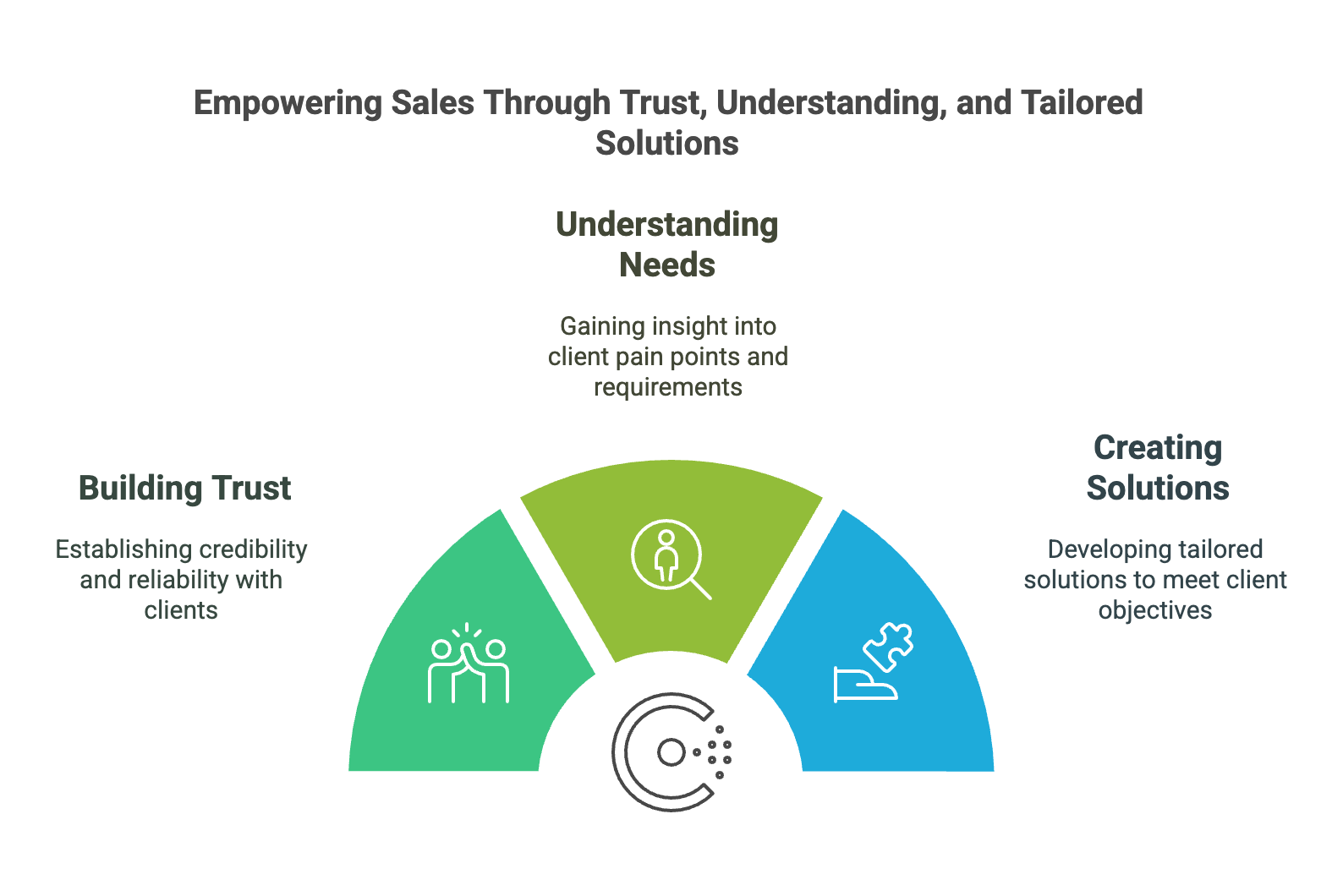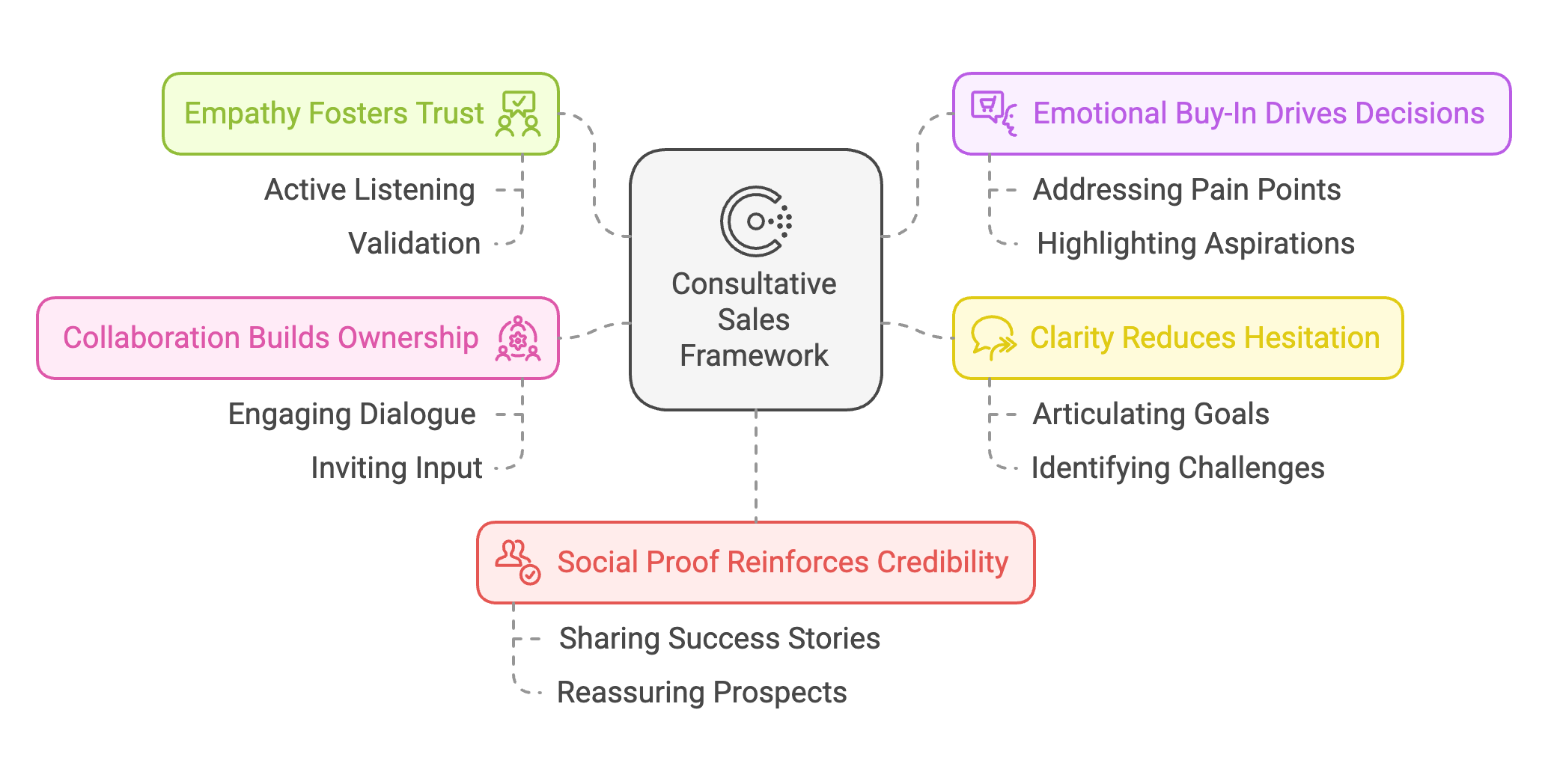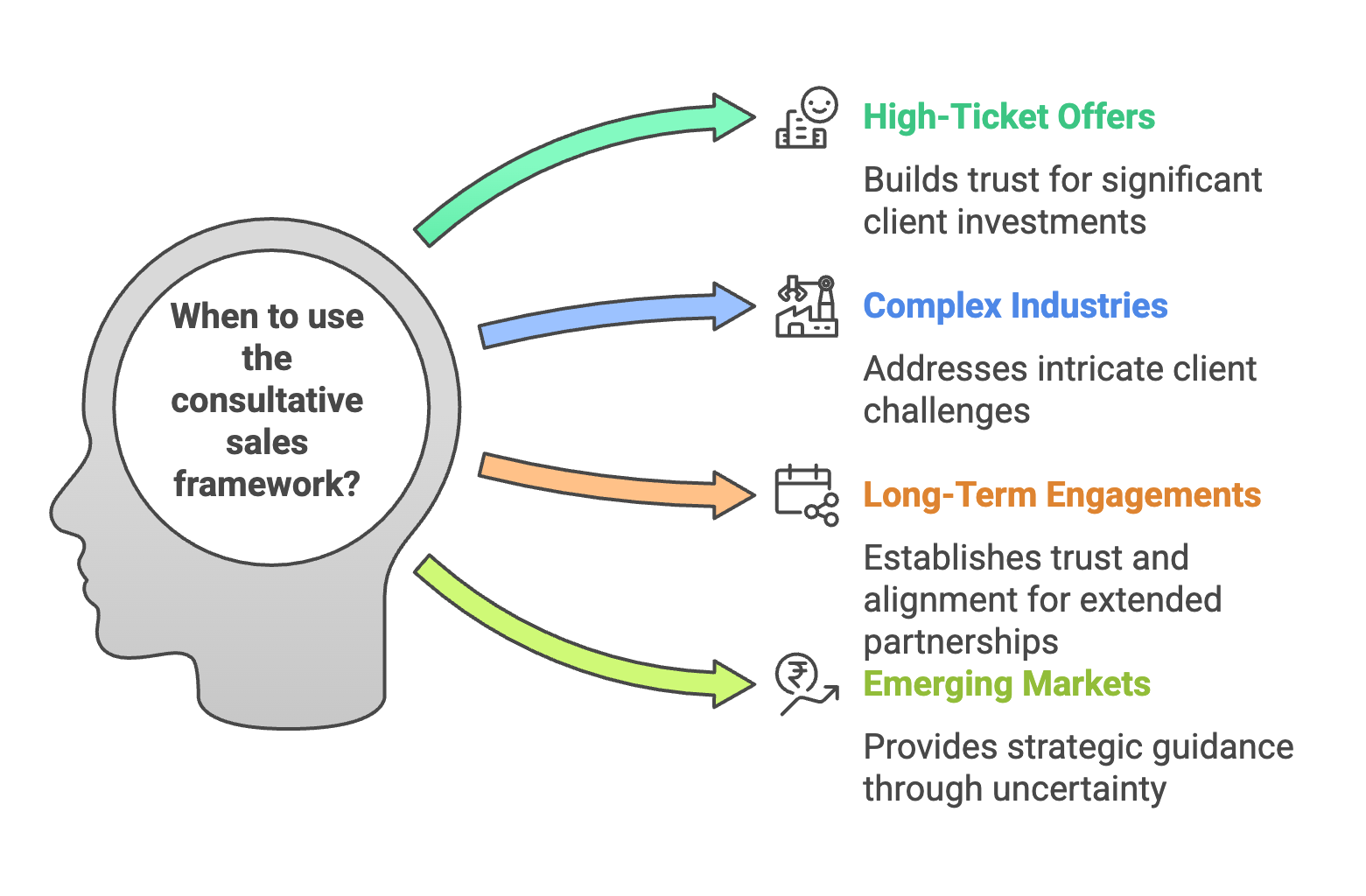Selling coaching and consulting services isn’t about hard pitches or flashy tactics, it’s about understanding your clients deeply and guiding them to the solutions they need. That’s where the consultative sales framework comes into play. By focusing on genuine connection and problem-solving, this method creates a pathway to meaningful conversations that lead to long-term relationships and trust.
Unlike traditional sales approaches, the consultative sales framework emphasizes collaboration over persuasion. It’s about asking the right questions, actively listening, and aligning your services with the client’s goals. Whether you’re helping a business owner scale their operations or guiding an individual through personal development, this strategy ensures you’re delivering solutions that resonate.
When you implement the consultative sales framework, you’re not just selling… you’re partnering with your clients to co-create success. This shift in perspective transforms the sales process from a transactional experience into a value-driven journey. It allows you to position yourself as a trusted advisor, ensuring your services stand out in a competitive marketplace.
In this post, we’ll break down the consultative sales framework, explain how it works, and show you how to use it to sell coaching or consulting services effectively. From asking the right questions to avoiding common pitfalls, you’ll discover how to leverage this approach to grow your business and deliver maximum value to your clients.

What Is the Consultative Sales Framework?
The consultative sales framework is a client-focused approach to selling that prioritizes listening, understanding, and problem-solving over traditional pitching. Rather than delivering rehearsed presentations or hard-sell tactics, this method revolves around meaningful conversations that help uncover your prospective client’s pain points, goals, and challenges.
At its heart, this framework positions you as a trusted advisor, not just a service provider. It shifts the sales dynamic from being transactional to relational, allowing you to build authentic connections. Instead of viewing the sales process as a means to close a deal, you approach it as an opportunity to co-create solutions that align with your client’s unique needs.
This framework is especially powerful in coaching and consulting, where the value lies in tailoring your expertise to address specific challenges. By focusing on the client’s objectives, you demonstrate a deep commitment to their success, which naturally leads to stronger trust and better outcomes.
Key benefits of the consultative sales framework include:
- Building Trust and Credibility: By focusing on the client’s story and goals, you position yourself as a dependable guide who genuinely cares about their success.
- Understanding Your Client’s Needs: Through thoughtful questions and active listening, you gain a clearer understanding of how your services can address their pain points.
- Creating Personalized Solutions: This collaborative process ensures that the solutions you offer feel tailored and relevant, increasing the likelihood of a successful partnership.
Ultimately, the consultative sales framework creates a win-win scenario: your clients feel seen and heard, and you gain the insights needed to provide exceptional value. This combination of empathy and strategy is what makes the framework so effective—and why it’s a must-have tool for any coach or consultant looking to grow their business.

The Psychology Behind Consultative Selling
The consultative sales framework isn’t just a method—it’s deeply rooted in psychology, making it one of the most effective approaches for building meaningful client relationships. When prospects feel understood and supported, they naturally develop trust, which is the cornerstone of any successful business transaction. This framework leverages several key psychological principles to create a dynamic that feels collaborative rather than transactional.
Empathy Fosters Trust
Actively listening to a client’s challenges and validating their concerns engages their emotions in a powerful way. This sense of being understood triggers the psychological principle of reciprocity—they’re more likely to trust and collaborate with you because they feel valued. Empathy also breaks down barriers of skepticism, positioning you as a trusted advisor rather than just another salesperson.
Example: When a prospect shares frustrations about inefficiencies in their workflow, acknowledging their feelings with statements like, “That sounds really frustrating; I can see why it’s holding you back,” builds an immediate connection.
Emotional Buy-In Drives Decisions
Emotions play a significant role in decision-making, especially for high-stakes investments like coaching or consulting services. By addressing their pain points and aspirations, you create an emotional connection that makes your solutions feel indispensable. Prospects aren’t just buying a service—they’re buying relief from their struggles or a path to their aspirations.
Example: Highlighting how a tailored marketing strategy can ease their stress over declining sales taps into both their pain (stress) and their desire for growth (aspiration).
Clarity Reduces Hesitation
One of the most common reasons prospects hesitate to commit is uncertainty. A consultative approach brings clarity by helping them articulate their goals, identify their challenges, and see a clear path forward. When they have a better understanding of their situation and your proposed solution, they’re more likely to act confidently.
Example: Breaking down a complex problem, like scaling operations, into manageable steps gives prospects a sense of control and reduces the overwhelming nature of the challenge.
Collaboration Builds Ownership
When prospects feel involved in creating the solution, they develop a sense of ownership over it. The consultative approach engages them in a dialogue where their input shapes the strategy, making them more invested in the outcome.
Example: Asking, “How do you envision this solution working for your team?” invites collaboration, signaling that their perspective matters and reinforcing their commitment to the plan.
Social Proof Reinforces Credibility
Sharing relevant success stories during the consultation not only builds trust but also taps into the psychological principle of social proof. When prospects see that others in similar situations have benefited from your expertise, it reassures them that your solution will work for them too.
Understanding and applying these psychological triggers allows you to engage with your prospects on a deeper level. This ensures that your sales process feels both effective and authentic, creating a foundation for long-term success.
The Five Key Questions in the Consultative Sales Framework
These five questions form the foundation of the consultative sales framework, guiding meaningful conversations that uncover client needs, clarify goals, and create a roadmap for delivering solutions. Each question serves a specific purpose in building trust, diagnosing problems, and positioning your services as the ideal solution.
Tell Me About Your Business?
This question opens the conversation and sets the stage. It gives your client a chance to share their story, successes, and challenges in their own words, while providing you with essential context about their operations, industry, and ambitions.
This isn’t just small talk, it’s a strategic opportunity to uncover underlying pain points that might not be immediately obvious. By actively listening and asking follow-up questions, you can demonstrate genuine interest and begin forming a deeper connection.
Example: If a client says they’re struggling to scale their operations, this could highlight areas where your expertise can make an immediate impact, such as creating scalable systems or improving operational efficiency.
Where Are You at Now?
This question digs into the present state of their business. It’s about assessing the baseline, from revenue numbers to team dynamics, and identifying current pain points. This is where you gather data that will help you create a tailored solution.
Encourage clients to be specific in their answers, as the details they provide can reveal underlying challenges they might not have fully considered. This question also sets a benchmark against which progress can be measured later.
Example: If a client is generating leads but struggling to convert them, you could identify a gap in their sales funnel as a key area to address.
Where Do You Want to Go?
Here, you uncover the client’s ultimate goals or vision for their business. This question shifts the focus from problems to possibilities, tapping into their aspirations and long-term objectives. Whether they want to scale revenue, expand their team, or launch a new product, understanding their “why” is critical.
By clarifying their goals, you can align your services with their desired outcomes and highlight how your expertise will help them achieve those results. It also opens the door to discuss measurable KPIs that will define success.
Example: If a client’s goal is to increase revenue by 50% in the next year, you can tailor your consulting solutions to align with this target.
How Do You Think You’ll Be Able to Get There?
This question reveals the client’s current strategies or ideas and highlights gaps or uncertainties they may have. It’s an opportunity to assess whether their approach is realistic, effective, or missing critical elements.
You can also use this question to subtly showcase your expertise. By refining their ideas or offering a fresh perspective, you position yourself as a valuable partner in their success. It’s about balancing support with strategy—showing them you’re there to enhance their plans, not override them.
Example: If a client mentions plans to increase marketing spend but has no tracking system, you can suggest building a data-driven strategy to optimize their efforts.
What’s the Cost of Not Knowing What to Do Next?
This question creates urgency by helping clients visualize the consequences of inaction or poor decision-making. It reframes the conversation from being about potential gains to the risks of staying stagnant or making missteps.
Encourage clients to think about both tangible and intangible costs—lost revenue, wasted time, team burnout, or missed market opportunities. This question taps into their emotions and makes the decision to invest in your services feel like a necessary step toward avoiding those losses.
Example: Highlighting how much revenue they’re losing by not addressing operational inefficiencies can be a powerful motivator.
By structuring your client conversations around these key questions, you create a consultative relationship built on trust, empathy, and expertise. This approach ensures your services are perfectly aligned with their needs and goals while setting the foundation for long-term success.
Why the Consultative Sales Framework Works
The consultative sales framework stands out because it’s not about selling—it’s about connecting. By focusing on understanding your prospects’ unique challenges and aspirations, you create an environment of trust and collaboration that feels more like a partnership than a transaction. This approach not only makes clients feel valued but also ensures that the solutions you provide are tailored to their specific needs.
Unlike traditional sales tactics that often rely on high-pressure pitches and one-size-fits-all solutions, the consultative sales framework takes the time to explore the “why” behind the “what.” It’s not just about closing a deal; it’s about uncovering the deeper issues and goals driving your prospects. This intentional focus on understanding builds a strong foundation for a long-term relationship.
Here’s why this framework works so effectively:
It Builds Trust
When you take the time to listen and engage with a client’s needs, you naturally build trust. Instead of coming across as just another salesperson, you position yourself as a problem solver who genuinely cares about their success. Trust is the cornerstone of any successful sales relationship, and the consultative approach fosters it from the very first conversation.
It Differentiates You
Most of your competitors are focused on pitching their services, highlighting features, and pushing for a sale. By contrast, the consultative sales framework sets you apart. You’re not trying to sell something to everyone—you’re showing how your expertise can uniquely solve the client’s challenges. This personalized approach not only makes you stand out but also makes you memorable.
It Clarifies the Value
Clients don’t just buy products or services—they invest in outcomes. The consultative sales framework helps you clearly define the value of what you offer by tying it directly to the client’s goals and pain points. This isn’t about generic benefits; it’s about demonstrating how your solutions will make their lives better, easier, or more profitable.
It Creates Win-Win Scenarios
The client wins because they receive a solution that addresses their specific needs. You win because the relationship is built on mutual respect and understanding, paving the way for future collaboration. This framework ensures that both parties walk away feeling confident and satisfied.
By leveraging the consultative sales framework, you can shift the dynamic of your sales process from transactional to transformational. It’s an approach that not only drives sales but also builds meaningful, lasting client relationships that are the foundation of sustainable business growth.

When to Use the Consultative Sales Framework
The consultative sales framework shines in specific scenarios where trust, understanding, and tailored solutions are crucial. Unlike traditional sales tactics that focus on quick wins, this approach thrives in situations requiring deeper connections, strategic problem-solving, and high-value outcomes. Here’s a closer look at when it’s most effective:
High-Ticket Offers
When selling premium coaching or consulting packages, the stakes are significantly higher for the client. They’re not just purchasing a service; they’re making a sizable investment in their future. In these situations, clients need to feel absolute confidence in your expertise, and the consultative framework helps build that trust.
Example: A business owner considering a $10,000 coaching package won’t be swayed by generic promises. However, a thoughtful conversation that uncovers their pain points—like struggling with leadership skills or scaling operations—can demonstrate your ability to deliver tailored, high-impact solutions worth the price.
Complex Industries
In fields like technology, finance, or healthcare, clients often face intricate challenges that require nuanced understanding and expertise. A consultative approach allows you to delve into the specifics of their situation, addressing pain points that competitors using generic pitches might overlook.
Example: A healthcare provider needing help with patient engagement may face unique hurdles such as regulatory compliance or data security concerns. By thoroughly exploring their challenges and offering precise strategies, such as implementing HIPAA-compliant CRM software, you position yourself as a trusted, knowledgeable partner.
Long-Term Engagements
Clients considering extended partnerships, such as retainer-based consulting or ongoing coaching programs, prioritize trust and alignment above all else. The consultative framework lays the groundwork for these relationships by fostering collaboration and ensuring mutual understanding.
Example: A client hiring you for a 12-month consulting engagement will need assurance that you understand their business inside and out. Using the consultative approach to explore their long-term goals—such as expanding into new markets—can establish the alignment needed for a successful partnership.
Emerging or Uncertain Markets
In industries undergoing rapid change or disruption, clients often lack clarity about their next steps. The consultative framework helps guide them through uncertainty by diagnosing their challenges and offering strategic insights.
Example: A startup navigating a new market might be unsure how to allocate limited resources effectively. Through consultative conversations, you can help them identify priorities—like focusing on customer acquisition or refining their product-market fit—and create a clear path forward.
By recognizing when this framework is most applicable, you can tailor your sales conversations to resonate with your audience’s specific needs and concerns. Whether you’re closing a high-ticket sale, addressing a niche challenge, or building the foundation for a long-term relationship, the consultative sales framework ensures that your approach is both strategic and client-focused.

How to Implement the Consultative Sales Framework
The consultative sales framework isn’t just a mindset—it’s a strategic process that requires intentional preparation, active engagement, and clear follow-through. Implementing it effectively means blending empathy with expertise to guide prospects toward a solution that genuinely serves them. Here’s how to do it:
Prepare Thoroughly
Before meeting with a prospect, invest time in understanding their business and industry. Research their challenges, competitors, and potential goals. Review their website, social media presence, and any publicly available information that offers insight into their current situation. This preparation not only demonstrates your professionalism but also allows you to ask informed questions that immediately build rapport.
Active Listening
The cornerstone of the consultative sales framework is listening—really listening. When speaking with a prospect, give them your undivided attention. Take notes, acknowledge their responses, and ask thoughtful follow-up questions to dig deeper into their pain points and aspirations. Avoid the temptation to jump in with solutions too quickly; instead, allow the conversation to unfold naturally. Active listening shows respect and helps you uncover the nuances of their challenges.
Provide Insights
Once you’ve gathered enough information, shift from listener to advisor. Share tailored suggestions or ideas that address their specific needs. This isn’t about overwhelming them with information—it’s about demonstrating your expertise by providing actionable insights. For example, if a client struggles with lead conversion, you might suggest a streamlined sales funnel or a revised email marketing strategy.
Showcase Success Stories
Storytelling is a powerful way to build trust and credibility. Share examples of how you’ve helped other clients achieve similar goals or overcome similar challenges. Highlight measurable outcomes like increased revenue, improved efficiency, or enhanced customer retention. When prospects see real-world evidence of your capabilities, it reassures them that you’re the right person to help them succeed.
Present the Next Steps
End the conversation by clearly outlining how you can help them achieve their objectives. This is where you transition from exploration to action. Explain your process, the specific ways your services address their needs, and what working together will look like. Break down the next steps into manageable actions, such as scheduling a follow-up call, signing a contract, or starting a discovery session.
Follow Up with Value
Implementation doesn’t stop at the conversation. After your initial meeting, follow up promptly with additional value. This could be a recap of your discussion, relevant resources, or a customized proposal. Consistent and meaningful follow-ups reinforce your commitment to their success and keep the momentum moving forward.
By following these steps, you can transform your sales approach from transactional to transformational. The consultative sales framework isn’t about closing deals—it’s about opening doors to lasting partnerships built on trust, collaboration, and shared success.

Common Objections and How to Address Them
No matter how expertly you implement the consultative sales framework, objections are an inevitable part of the process. They aren’t necessarily roadblocks—they’re opportunities to address concerns, provide clarity, and deepen trust. Handling objections effectively ensures your prospects feel heard and reassured, making it easier for them to move forward confidently.
“I Need to Think About It.”
This common objection often signals uncertainty or fear of making the wrong decision. Instead of pressing for a commitment, keep the conversation open and supportive.
Reframe with empathy: “I completely understand. Can we go over any specific concerns or questions you might have to help clarify things?”
This approach encourages the prospect to voice their hesitation, giving you the chance to address it directly. For example, if they’re unsure about the timeline, you can explain how your process ensures steady progress and clear milestones.
Example: If a prospect is worried about dedicating time to a consulting engagement, you could highlight how you streamline the process, ensuring their involvement is manageable and impactful.
“It’s Too Expensive.”
When prospects bring up cost, they’re often unsure of the value they’ll receive. Shift the focus from the price tag to the results. Highlight how your services align with their specific goals and provide measurable benefits.
Respond with value: “While this is an investment, it’s designed to help you [specific outcome]. For example, by addressing [problem], you could save [X amount of time or money] or generate [Y amount of revenue].”
You can also offer examples of past clients who’ve achieved significant returns on their investment, reinforcing the idea that your services pay off in tangible ways.
Example: For a business owner hesitant about investing in a sales strategy consultation, you might explain how refining their sales funnel could lead to a 20% increase in conversions, offsetting the cost of your services many times over.
“I’m Not Ready Yet.”
This objection often comes from a place of fear or uncertainty about timing. Instead of pushing, create urgency by helping them visualize the cost of waiting.
Address the risk: “I completely understand wanting to feel ready. However, waiting might mean [missed opportunities, declining performance, or increased competition]. What would it mean for your business if this challenge continues for another six months?”
By shifting the focus to the consequences of inaction, you gently encourage the prospect to reconsider the urgency of their situation.
Example: If a prospect delays addressing an operational inefficiency, you could point out how that inefficiency is costing them thousands of dollars per month and how resolving it now could free up resources for growth.
“I’m Not Sure This Is the Right Fit.”
When a prospect doubts whether your services align with their needs, it’s an opportunity to clarify and build trust.
Reaffirm alignment: “I hear you, and I want to make sure this is a perfect fit. Can we revisit your goals and challenges together to confirm whether this solution meets your needs?”
This collaborative approach demonstrates your commitment to their success, even if that means acknowledging when your service isn’t the best fit. It’s this transparency that builds trust and credibility, often turning hesitation into a yes.
Tips for Handling Objections Effectively:
- Stay Calm and Empathetic: Avoid getting defensive. Show that you understand their concerns and are there to help.
- Ask Open-Ended Questions: Dive deeper into their objections to uncover the root cause of their hesitation.
- Provide Reassurance Through Stories: Share relatable success stories or examples that illustrate how you’ve helped others overcome similar concerns.
- Leave the Door Open: If a prospect still isn’t ready, make it clear that the conversation can continue when they are.
Addressing objections isn’t about overcoming resistance—it’s about building confidence. By responding with empathy, clarity, and genuine concern for their needs, you reinforce your role as a trusted advisor and make it easier for prospects to take the next step.

Common Mistakes to Avoid
The consultative sales framework is powerful, but its effectiveness can be undermined by common missteps. These pitfalls often stem from rushing the process or losing sight of the client-centric nature of this approach. Here’s what to watch out for and how to avoid falling into these traps:
Talking Too Much
While it’s tempting to showcase your expertise, dominating the conversation can backfire. The focus of the consultative sales framework is on the client, their needs, and their challenges. If you’re doing most of the talking, you’re likely missing valuable insights that could inform your solutions. Instead, aim for a balanced dialogue where the client feels heard and valued. Use open-ended questions to encourage them to share more about their business and challenges.
Being Too Vague
General promises like “I can help you grow your business” or “This will improve your bottom line” lack the specificity needed to build trust. Clients need to see a clear connection between their pain points and your proposed solutions. Tailor your responses to their unique situation. For example, if they mention a struggle with lead generation, you could share a specific strategy you’ve used to help similar clients generate qualified leads.
Rushing the Process
Patience is key in the consultative sales framework. Jumping to solutions too quickly can make clients feel like they’re being sold to rather than understood. Take the time to dig deep into their challenges and aspirations. Fully understanding their needs not only improves the solutions you offer but also strengthens the trust between you and the client.
Other pitfalls to be mindful of include:
- Failing to Follow Up: A lack of timely follow-up can undo the trust you’ve built during the conversation. Always follow through on any promises, whether it’s sending additional resources or scheduling a follow-up call.
- Overlooking Body Language or Tone: Pay attention to non-verbal cues during the conversation. If a client seems hesitant or disengaged, adjust your approach to reestablish connection and trust.
- Focusing on the Sale, Not the Solution: The goal of the consultative sales framework is to solve problems, not just close deals. If you prioritize making a sale over genuinely helping the client, they’ll sense it—and you’ll likely lose their trust.
By steering clear of these mistakes, you’ll not only enhance your ability to connect with prospects but also position yourself as a trusted advisor who genuinely cares about their success. This approach isn’t just good for your sales—it’s great for building long-term relationships that lead to repeat business and referrals.
Tools to Support the Consultative Sales Framework
Implementing the consultative sales framework effectively requires more than just skill—it demands the right tools to streamline processes and maximize the impact of your client interactions. Leveraging these resources not only saves time but also enhances your ability to build trust and deliver personalized solutions.
CRM Software: Streamline Client Management
Customer Relationship Management (CRM) software like HubSpot, Salesforce, or Zoho CRM is essential for tracking client interactions, managing follow-ups, and organizing client data. These tools allow you to document each prospect’s responses to your key questions, ensuring nothing falls through the cracks.
Example: Imagine a client shares during an initial meeting that their main challenge is operational inefficiency. With CRM software, you can log this detail and follow up with tailored suggestions during your next interaction, showcasing your attentiveness and expertise.
Note-Taking Apps: Keep Conversations Organized
Detailed note-taking is critical in the consultative sales framework, and tools like Evernote, Notion, or Microsoft OneNote provide an easy way to organize your insights. Use them to capture key takeaways, highlight client pain points, and jot down action items during or immediately after a meeting.
Example: A coach using Notion can quickly pull up notes from past meetings to remind a client about their previously discussed goals, reinforcing the continuity and professionalism of their services.
Scheduling Tools: Simplify Follow-Ups
Follow-up conversations are a crucial part of the consultative sales process, and tools like Calendly or Acuity eliminate the back-and-forth of scheduling. By providing clients with a seamless way to book meetings, you enhance the overall experience while ensuring timely follow-ups.
Example: After an initial consultation, a consultant can send a Calendly link for the client to schedule the next session at their convenience. This not only makes the process easier but also keeps the momentum going.
Presentation Tools: Deliver Tailored Proposals
Visuals and presentations can significantly enhance the impact of your consultations. Platforms like Canva, Google Slides, or Keynote enable you to create customized proposals, infographics, or other visuals that illustrate your value proposition.
Example: A consultant pitching a workflow improvement strategy could use Canva to design a professional slide deck that outlines the steps, expected outcomes, and timeline, making their recommendations more tangible and compelling.
Communication Platforms: Stay Connected
Tools like Slack, Zoom, or Microsoft Teams ensure that you maintain clear and consistent communication with clients. Whether it’s for virtual consultations or ongoing collaboration, these platforms provide the flexibility to connect anytime, anywhere.
Example: A business coach can use Zoom to conduct initial consultations with clients worldwide, breaking down geographical barriers and expanding their reach.
Analytics and Reporting Tools: Measure Success
Tracking your effectiveness is vital, and tools like Google Analytics, Klipfolio, or custom dashboard software help you measure the outcomes of your strategies. Whether it’s tracking conversions from a new sales funnel or analyzing the performance of a client’s marketing campaigns, these tools provide data-driven insights to refine your approach.
Example: After implementing a new lead-generation strategy for a client, you can use Google Analytics to demonstrate how their website traffic and conversions have improved, reinforcing the value of your services.
Why Tools Matter in the Consultative Framework
Using the right tools allows you to focus on the human side of selling while automating and simplifying administrative tasks. By integrating these resources into your workflow:
- You can ensure no detail is overlooked, strengthening trust with your clients.
- Your follow-ups and proposals become more professional and personalized.
- You free up time to focus on building meaningful relationships rather than getting bogged down in logistics.
Investing in these tools isn’t just about efficiency—it’s about elevating the overall client experience. When your process is seamless and well-supported, it reflects the professionalism and care that sets you apart in a competitive market.

Real-Life Success Stories
The consultative sales framework isn’t just a theoretical approach—it’s a proven method that has transformed businesses and careers. By focusing on understanding client needs and tailoring solutions, it has delivered tangible results across industries. Here are more examples of how this framework has driven success:
- The Startup Founder: Scaling Smartly
A tech startup founder struggled with scaling their operations. They had strong revenue growth but lacked a clear plan to expand their team without overwhelming their existing resources. During a consultative sales call with a business coach, they explored key challenges, such as high employee turnover and inefficient hiring practices. The coach recommended implementing a scalable recruitment system, complete with automated onboarding tools and defined roles for new hires.
Outcome: Within six months, the startup doubled its team while maintaining operational efficiency, resulting in a 45% increase in overall productivity. - The Digital Marketer: Working Smarter, Not Harder
A freelance digital marketer was overwhelmed by juggling multiple clients, missed deadlines, and inconsistent income. During a consultation, a business consultant uncovered that poor time management and a lack of prioritization were causing most of the stress. Together, they developed a tailored workflow system that included time-blocking, automated reporting, and a client prioritization matrix.
Outcome: The marketer increased client capacity by 30%, improved deliverable quality, and maintained a healthier work-life balance without extending work hours. - The Boutique Owner: Boosting Revenue with Data
A small boutique owner approached a retail consultant to help boost declining sales. During the consultation, the owner revealed they had no system for tracking customer preferences or buying habits. By implementing customer relationship management (CRM) software and personalized email campaigns, they were able to target repeat customers with tailored product recommendations and promotions.
Outcome: Monthly revenue increased by 25%, with returning customers accounting for 60% of the growth. - The Nonprofit Director: Driving Donor Engagement
A nonprofit organization struggled to retain donors and secure recurring contributions. Through the consultative sales framework, a fundraising consultant identified gaps in their communication strategy. The consultant recommended segmenting their donor database to send personalized updates and appeals, as well as hosting virtual donor appreciation events to deepen engagement.
Outcome: Donor retention improved by 35%, and recurring monthly donations increased by 50%, providing the nonprofit with more predictable funding for its programs. - The Wellness Coach: Expanding Reach
A wellness coach wanted to grow their business but felt overwhelmed by inconsistent client bookings and limited visibility. During a consultative session, the coach and a business strategist pinpointed social media marketing as an untapped opportunity. The strategist recommended a streamlined content calendar and leveraging short-form video content for Instagram and TikTok to showcase expertise.
Outcome: Within three months, the wellness coach doubled their social media following, increased client inquiries by 50%, and successfully launched a group coaching program.
These success stories illustrate the power of the consultative sales framework to deliver meaningful results across diverse industries. By tailoring solutions to individual challenges and goals, this approach not only solves immediate problems but also lays the foundation for sustainable growth.

Key Metrics for Measuring Success with the Framework
To ensure your consultative sales framework delivers results, it’s essential to track key performance indicators (KPIs) that provide insights into its effectiveness. These metrics not only help you gauge success but also highlight areas for refinement. By regularly monitoring these data points, you can make informed adjustments that lead to even greater impact.
Conversion Rates: Measure Engagement and Success
Conversion rates track how many prospects transition from initial consultations to signed clients. A high conversion rate indicates that your framework resonates well with prospects, effectively addressing their needs and building trust.
Example: If you notice a dip in conversions, analyze where prospects might lose interest. Are you addressing their pain points thoroughly? Is your follow-up process clear and timely? Use this insight to refine your conversations and follow-ups.
Average Deal Size: Assess Financial Impact
Tracking the average value of your deals provides clarity on how impactful your approach is financially. A growing deal size indicates that you’re successfully positioning your services as premium solutions worthy of higher investments.
Example: If your average deal size is stagnating, consider upselling additional services or highlighting the long-term value of your solutions during consultations. Tailored recommendations can also encourage clients to invest more deeply in your offerings.
Client Retention: Build Long-Term Relationships
Retention rates measure how long clients stay with you after the initial sale. High retention reflects trust, satisfaction, and the effectiveness of your solutions.
Example: If retention rates are lower than expected, evaluate the onboarding process and post-sale engagement. Are you continuing to provide value after the initial purchase? Regular check-ins, additional resources, and tailored solutions can help maintain and strengthen client relationships.
Referral Rates: Gauge Relationship Strength
Happy clients often recommend your services to others, making referral rates a powerful metric for understanding the strength of your client relationships. A high referral rate indicates that your consultative approach not only solves problems but also leaves clients impressed enough to spread the word.
Example: If referrals are lacking, revisit your follow-up process to ensure clients are reminded of the value you provide. Consider introducing incentives for referrals, such as discounts on future services or exclusive perks.
Additional Metrics to Consider
- Time-to-Conversion: Measure how long it takes to move prospects through the sales funnel. If this time decreases, it’s a sign your framework is becoming more efficient.
- Proposal Acceptance Rate: Track how often prospects accept proposals after consultations. This helps you gauge how well your recommendations align with their needs.
- Client Satisfaction Scores: Use surveys or feedback forms to measure client satisfaction. High scores reflect the quality and effectiveness of your consultative approach.
Using Metrics to Refine Your Framework
Metrics are only valuable if you act on them. Regularly review your data to identify trends and opportunities for improvement:
- If conversion rates are low, refine your initial conversations to better address client pain points.
- If retention rates are slipping, focus on delivering more value during long-term engagements.
- If referral rates are stagnant, prioritize relationship-building touchpoints to enhance client loyalty.
By combining these KPIs with actionable insights, you can optimize your consultative sales framework to not only close more deals but also create lasting partnerships that fuel sustainable business growth.
Build Relationships, Not Just Sales
The consultative sales framework isn’t just a strategy for closing deals—it’s a way of fostering genuine, long-term relationships with your clients. When you shift the focus from selling to understanding, you create a deeper connection. Clients feel seen, heard, and valued, which builds trust and opens the door to collaboration. In an industry where trust is everything, this approach sets you apart from competitors who are simply chasing the next sale.
This framework helps you go beyond the transactional. By investing in meaningful conversations and tailored solutions, you’re not just addressing a client’s immediate needs—you’re laying the groundwork for repeat business, referrals, and glowing testimonials. The questions you ask and the insights you offer signal that you’re not just another service provider but a partner in their success.
When you implement this framework, you’re also making your own process more sustainable. Instead of chasing leads and relying on aggressive sales tactics, you’re building a pipeline of clients who genuinely appreciate your value. These relationships often lead to better client retention, more organic growth, and greater satisfaction for both you and your clients.
Ready to elevate your coaching or consulting business? Start incorporating the consultative sales framework into your conversations today. Remember, it’s not about making a sale—it’s about solving problems and creating impact. That’s how you build a reputation, expand your influence, and achieve lasting success.




